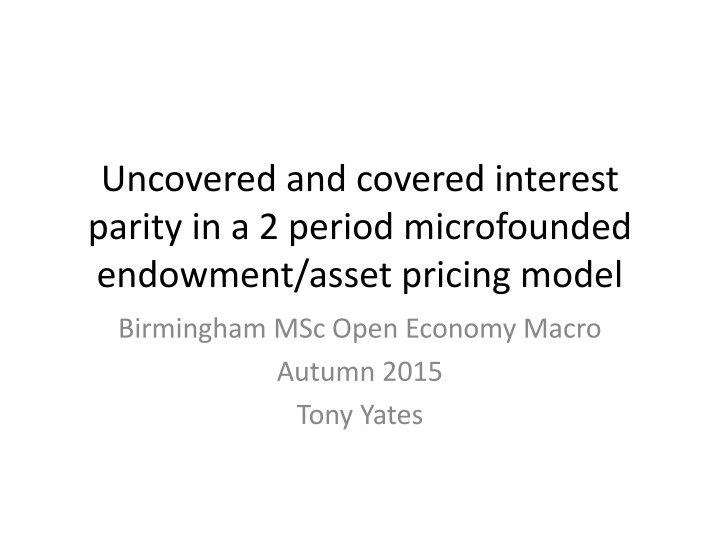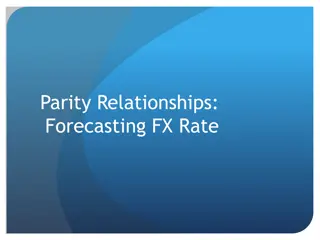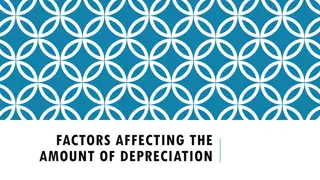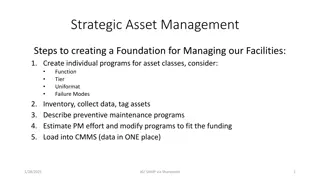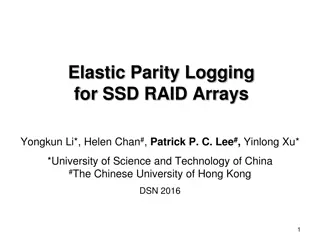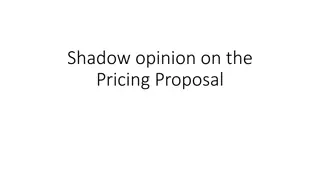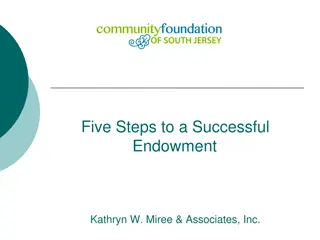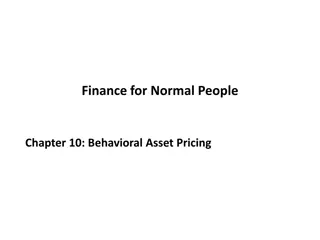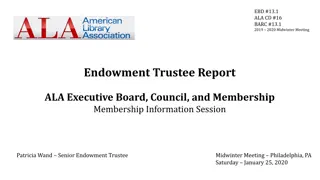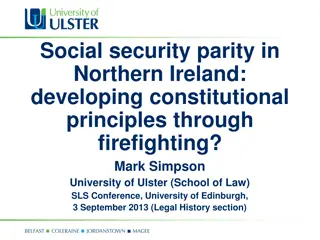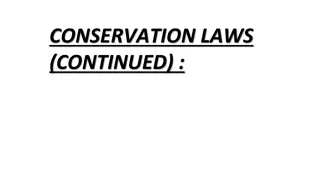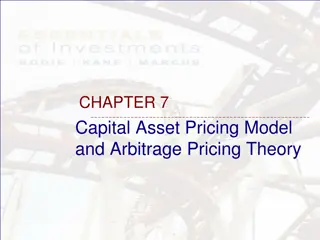Uncovered and Covered Interest Parity in Endowment/Asset Pricing Model
Study the implications of uncovered and covered interest parity in a 2-period microfounded endowment/asset pricing model. Explore the macroeconomic influences on exchange rates and interest rates, the failures in forecasting future exchange rate movements, and key assumptions underlying the model.
Download Presentation

Please find below an Image/Link to download the presentation.
The content on the website is provided AS IS for your information and personal use only. It may not be sold, licensed, or shared on other websites without obtaining consent from the author.If you encounter any issues during the download, it is possible that the publisher has removed the file from their server.
You are allowed to download the files provided on this website for personal or commercial use, subject to the condition that they are used lawfully. All files are the property of their respective owners.
The content on the website is provided AS IS for your information and personal use only. It may not be sold, licensed, or shared on other websites without obtaining consent from the author.
E N D
Presentation Transcript
Uncovered and covered interest parity in a 2 period microfounded endowment/asset pricing model Birmingham MSc Open Economy Macro Autumn 2015 Tony Yates
Intro Recall we met uncovered interest parity in the Dornbusch, Mundell Fleming model. If there is a gap between home and foreign interest rates, arbitrage must mean that there is expected to be a change in exchange rates to equalise returns to assets in different countries.
Why study UIP? Financial sector participants need coherent and reliable tools to diagnose and forecast exchange rate/interest rate movements Policy makers likewise, since ex rate key influence on eg inflation and unemployment. Key diagnostic of our macro models if we can build sound links from the model to exchange rates and interest rates. Unfortunately, doing this generates many puzzles for international macro economists.
Interest rate gaps typically fail to forecast future exchange rate movements. We ll see this in more detail after we have done the theory. Why the predictions of the model fail generates rich debates about measurement, theory and econometric techniques.
The model 2 periods Period 1 is certain Period 2, endowment is uncertain 2 states, good and bad, with probability pi, 1- pi Consumers maximise utility over the 2 periods Have to choose consumption and location of investment at home or abroad.
Key assumptions Rational expectations, but not perfect foresight: can t predict which state happens. Not too hard to relax, but a wilderness of alternatives. Optimising consumers Hard to relax, and questionable. Only 2 states, good and bad. Perfect markets. Harder to relax, and questionable. No production Just for simplicity. No problem to generalise. Only 2 periods. Just for simplicity so we can do algebra, without using numerical solutions.
Remark on our model agent lifespans You have met infinitely lived agents And now we will work with agents who live for 2 periods and then the world stops. Other kind of model we won t cover in this course: overlapping generations models [OLG]. Infinite duration world of finitely-lived agents. All false, but all have their uses.
Period one budget constraint B1 Q1 S1 P1c1 B1 S1B1 Nominal consumption +saving in home bonds +insured savings in foreign bonds +uninsured savings in foreign bonds = nominal endowment [ie in s] Insurance contract involves: (1+i_1)B_1_star at agreed forward exchange rate F_1.
Period 2 good state budget constraint B1 gc2 g Q2 g 1 i B1 F1 1 i B1 g 1 i S2 P2 Nominal consumption= Good state endowment +proceeds from redemption of home bonds plus interest +proceeds from redemption of insured foreign bonds +proceeds from sale of uninsured foreign bonds Note there is an equivalent budget constraint for the bad state too.
Consumer-investors 2 period optimisation problem g 1 u c2 b U u c1 u c2 Utility function , g,c2 Choice variables b,B1,B1 c1,c2 B1 g,P2 g,S2 g,Q2 b,S1,S2 b,Q1,Q2 b,i ,i, F1 P1,P2 Variables taken as given [each consumer too small to affect endogenous aggregate variables]
Dynamic optimisation method: comment Previous lectures on EK and the SOE model, we used Lagrangian methods. We could use those here. But here we just use the budget constraint to substitute out for consumption choice variables [c_1,c_2_g,c_2_b] ..and then optimise wrt the remaining [B_1,B__1_*,B_1_tilda_*]
Re-writing 3 budget constraints in terms of 3 consumption variables B1 S1 c1 Q1 B1 S1B1 P1 B1 g 1 i B1 F1 1 i B1 g 1 i S2 g Q2 c2 g P2 B1 b 1 i B1 F1 1 i B1 b 1 i S2 b Q2 c2 b P2 We have 3 budget constraints. Period 1, Period 2 good state, Period 2 bad state. Use them to get an expression for the corresponding consumption variables. We ll then use these expressions to substitute out for the consumption variables in the 2 period, probability weighted utility function that we are maximising.
The expected utility function maximand, recast B1 S1 U u Q1 B1 S1B1 P1 B1 g 1 i B1 F1 1 i B1 g 1 i S2 u Q2 g P2 B1 b 1 i B1 F1 1 i B1 b 1 i S2 1 u Q2 b P2 Here we have eliminated consumption terms using the expressions in last slide. Now we differentiate wrt the B s, yielding 3 FOCs. Note that we don t specify the utility function. Sometimes it s nice to preserve generality. We require some things of it, like continuous differentiability .
Deriving the FOCs dU dB1 1 P1u c1 1 i 1 P1u c1 1 i g 1 i b 0 g u c2 b 1 u c2 P2 P2 g 1 i b g u c2 b 1 u c2 P2 P2 Note the use of the chain rule to differentiate wrt something inside the unspecified utility function. LHS=utility from consuming 1 unit of home currency RHS=forecast utility of not spending but investing and consuming next period
Re-writing that FOC wrt home bonds B_1 1 P1u c1 Divide both sides of that FOC by this to get this. g b u c2 u c1 u c2 u c1 P1 P2 P1 P2 1 1 i g 1 b u c2 u c1 Now re-write using the expectations operator, so we don t have to handle the pi s all the time. P1 P2 1 1 i E1
More rewriting, using defn of the pricing kernel u c2 u c1 Define this ratio of marginal utilities in 2 periods to be the pricing kernel P1 P2 M2 Important object in finance. And use this to rewrite our FOC wrt B_1, domestic bond holdings, like this. 1 1 i E1M2 We will treat the other FOCs analogously, and via the LHS 1s we can equate them, and then derive conditions under which UIP hold
Apply same steps to the FOC wrt insured foreign bond purchases g F11 i P1u c1 F11 i S1 dU dB1 b 0 g u c2 b 1 u c2 P2 P2 Some algebra to get to this point. g b u c2 u c1 u c2 u c1 1 1 i F1 P1 P2 P1 P2 g 1 b S1 u c2 u c1 1 1 i F1 P1 P2 S1E1 Eliminate pi s by using the E operator. Use defn of pricing kernel to re- write FOC like this. 1 1 i F1 S1E1M2
Covered interest parity 1 i F1 S1E1M2 1 i E1M2 1 i F1 1 i [3] S1 We manipulated our 2 FOCs to get equations with 1 on the LHS. So we equate them, and derive the CIP condition. Now, we turn to asking whether uncovered interest parity [UIP] holds or not, given that CIP holds. We ll see that it does not necessarily hold.
Uncovered interest parity S2 S1 1 i 1 i E1 Uncovered interest parity requires this. We established that covered interest parity holds, which means that given that, for UIP to hold requires. 1 i F1 S1 1 i That the forward rate = expected future exchange rate. F1 E1S2 This won t generally be true, but will sometimes.
Recap, and UIP To investigate when UIP holds, we return to working on the 3rd FOC, wrt uninsured bonds. Same process: Differentiate wrt the choice variable Set = 0 to get the FOC Algebra to get 1=[ .] Simplify using expectations operator to get rid of pi s Simplify using defn of pricing kernel M
UIP: working on the 3rd FOC wrt uninsured bond purchases g 1 i g b 1 i b P1u c1 S2 g S2 S1 dU b 0 u c2 1 u c2 P2 P2 dB1 g g b b u c2 u c1 u c2 u c1 1 1 i S2 g 1 S2 P1 P2 P1 P2 As before .Manipulate to get 1 on LHS S1 S1 b u c2 u c1 S2 S1 P1 P2 1 i E1 Use expectations operator.. S2 S1M2 1 1 i E1 Use defn of pricing kernel.
Does the forward rate=expected spot exchange rate? No. 1 1 i F1 This is what we derived from the 2nd FOC wrt uninsured foreign bond purchases S1E1M2 Together with what we figured out from the 3rd FOC wrt uninsured foreign bond purchases, this holds. S2 S1M2 F1 S1E1M2 E1 Which implies this relationship. F1E1M2 E1S2M2 But that does NOT imply this condition, which we require for UIP to hold. F1 E1S2
Recap and stock take: what were we doing again? We established covered interest parity held, and we wanted to know whether UIP held. We worked out that if CIP held, then for UIP to hold meant the forward rate=expected future spot rate. And we concluded that this didn t hold in general. But now we will assert that if pricing kernal and exchange rate are uncorrelated, it will be true. To do that, a recap on random variable algebra..
Recap on algebra of covariances cov a,b E a E a b E b E ab E a E b aE b bE a E ab E a E b E aE b E bE a E ab E a E b E ab cov a,b E a E b The above is true for any 2 random variables a and b. Now we will apply this to our investigation of when the CIP condition holding implies that the UIP condition holds . to assert that UIP does hold if cov[M_2,E_2]=0.
Applying the uncorrelatedness assumption S2 S1M2 S2 S1,M2 E1 S2 S1 E1 cov E1M2 S2 S1M2 We can rewrite the eqn that came from the FOC wrt uninsured bonds 1 1 i E1 S2 S1,M2 S2 S1.E1M2 1 1 i cov E1 Like this S2 S1.E1M2 Then assume the covariance=0. 1 1 i E1
Showing UIP holds under uncorrelatedness of M and S_2/S_1 S2 S1.E1M2 This is what we just derived. 1 1 i E1 This was the eqn that came from the FOC wrt insured bond purchases. 1 1 i F1 S1.E1M2 Combining them, dividing by term in i_* E1S2 S1.E1M2 F1 S1.E1M2 E1S2 S1 1 S1E1S2 F1 E1S2 F1 F1 S1 S1 We see that the forward rate=expected future spot rate.
Showing UIP holds using the F=E(S_2) result This eqn came from the FOC wrt home bond purchases. 1 1 i E1M2 This came from FOC wrt insured foreign bond purchases. 1 1 i F1 S1.E1M2 1 1 i E1M2 1 i ES2 .E1M2 S1 Inserting our F=E(S_2) assumption and combining, yields the UIP condition. 1 i 1 i ES2 S1
Another stock take on what we just found We just assumed that the pricing kernel and the change in the exchange rate were uncorrelated. That led us to derive that the forward rate = expected spot rate. That s the condition we need to establish that UIP holds [given that we already saw that CIP holds].
Is the uncorrelatedness assumption strong? That pricing kernel is a f(ratio of marginal utilities of consumption). That will be a f (change in consumption) Think back to our models of the real exchange rate [which we d expect to influence the nominal exchange rate] They explained how RER=f(productivities). So consumption also likely to be a f(productivities). Hence uncorrelatedness won t hold. Hence UIP won t hold exactly.
UIP in logs. Basis for empirical work on the carry trade. log 1 x x When x is small, this is true. log 1 i log 1 i ES2 Which means we can write UIP in log terms. S1 log 1 i log ES2 log S1 i i Es2 s1[1] And this is how the empirical work usually proceeds. Which, as noted, finds that UIP fails, in particular that LHS>RHS in the data.
Themes on Empirical work bearing on UIP Does any model do better at forecasting the exchange rate than a random walk assumption? The forward discount anomaly Empirical investigations of rationality of forecasts
Meese-Rogoff (1983) EtSt 1 St This is a random walk forecasting model. It s very hard to find a model that beats it. Despite the fact that UIP and all the other assumptions that make up a macro model provide us with many alternatives.
Forward discount st 1 st ft st ut 1 0, If UIP holds, it should be that the forward rate = expected future spot rate. Hence this regression should yield these estimated coefficients. 1 These restrictions always rejected very strongly. In fact we see beta<1.
Rationality of forecasts ft st 1 ixit ut Treat f_t-s_t+1 as a forecast error. Should be uncorrelated, under RE, with anything in information set at time t when forecast was made. UIP invokes RE. So if RE fails so will UIP.
Rationality and forecast revisions F1,n,F2,n,F3,n,F4,n....Fn 1,n R21 F2,n F1,n,R32 F3,n F2,n,....Rn 1n 2 Fn 1,n 2 Imagine sequence of forward contracts [forecasts] delivering currency at date n. We can construct a sequence of forecast revisions. i) ii) Forecast revisions should not explain forecast errors. Forecast revisions should not be predictable [eg autocorrelated, or explicable with anything in the agent s info set at time forecast made.
A stationarity test st 1 st ft st ut 1 LHS is stationary, even though s_t itself is not. So RHS should be stationary. Sometimes RHS found not to be stationary.
Issues with tests of UIP related hypotheses Risk premia, and changing risk premia, can interfere. Expectations may not be rational. Yet, tests of rationality may themselves incorrectly reject it if information, in small samples, emerges gradually . Since that can generate autocorrelated forecast errors, amongst other things.
Market illiquidity can contaminate the forward price as a measure of the expected future exchange rate.
